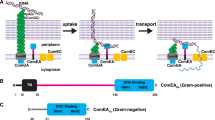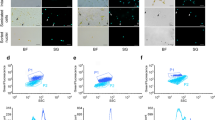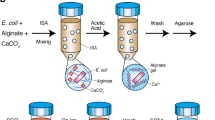Abstract
In this protocol, we present a standard method for extracting DNA from cells of the social amoeba Dictyostelium discoideum. While this procedure is similar to other phenol:chloroform-based purification methods, it is modified to account for the high level of carbohydrate and nucleases found in Dictyostelium cells. Genomic DNA can be isolated from wild-type and genetically modified cells using the described protocol, allowing molecular genetic analyses to be performed. Following cell lysis, nucleic acid extraction, and precipitation, the isolated DNA is suitable for digestion by restriction enzymes, amplification by PCR and Southern blotting. This procedure takes approximately 3 h to complete.
This is a preview of subscription content, access via your institution
Access options
Subscribe to this journal
Receive 12 print issues and online access
$259.00 per year
only $21.58 per issue
Buy this article
- Purchase on Springer Link
- Instant access to full article PDF
Prices may be subject to local taxes which are calculated during checkout

Similar content being viewed by others
References
Chisholm, R.L. & Firtel, R.A. Insights into morphogenesis from a simple developmental system. Nat. Rev. Mol. Cell Biol. 5, 531–541 (2004).
Firtel, R.A. & Chung, C.Y. The molecular genetics of chemotaxis: sensing and responding to chemoattractant gradients. BioEssays 22, 603–615 (2000).
Mahadeo, D.C. & Parent, C.A. Signal relay during the life cycle of Dictyostelium . Curr. Top. Dev. Biol. 73, 115–140 (2006).
Eichinger, L. et al. The genome of the social amoeba Dictyostelium discoideum . Nature 435, 43–57 (2005).
Chisholm, R.L. et al. dictyBase, the model organism database for Dictyostelium discoideum . Nucleic Acids Res. 34, D423–D427 (2006).
Cardelli, J.A., Golumbeski, G.S., Woychik, N.A., Ebert, D.L., Mierendorf, R.C. & Dimond, R.L. Defining the intracellular localization pathways followed by lysosomal enzymes in Dictyostelium discoideum . in Methods in Cell Biology. Volume 28: Dictyostelium discoideum: Molecular Approaches to Cell Biology (ed. J.A. Spudich) 139–155 (Academic Press Inc., Orlando, FL, 1987).
West, C.M., van der Wel, H., Coutinho, P.M. & Henrissat, B. Glycosyltransferase genomics in Dictyostelium discoideum . in Dictyostelium Genomics (eds. W.F. Loomis & A. Kuspa) 23–40 (Horizon Bioscience, Norfolk, 2005).
Nellen, W. et al. Molecular biology in Dictyostelium: tools and applications. in Methods in Cell Biology. Volume 28: Dictyostelium discoideum: Molecular Approaches to Cell Biology (ed. J.A. Spudich) 67–100 (Academic Press Inc., Orlando, FL, 1987).
Charette, S.J. & Cosson, P. Preparation of genomic DNA from Dictyostelium discoideum for PCR analysis. BioTechniques 36, 574–575 (2004).
Adley, K.E., Keim, M. & Williams, R.S.B. Pharmacogenetics: defining the genetic basis of drug action and inositol triphosphate analysis. in Methods in Molecular Biology. Volume 346: Dictyostelium discoideum Protocols (eds. Eichinger, L. & Rivero, F.) 517–534 (Humana Press, Totowa, NJ, 2006).
Sambrook, J., Fritsch, E.F. & Maniatis, T. Molecular Cloning: A Laboratory Manual (Cold Spring Harbor Laboratory Press, Woodbury, NY, 1989).
Fey, P., Stephens, S., Titus, M.A. & Chisholm, R.L. SadA, a novel adhesion receptor in Dictyostelium . J. Cell Biol. 159, 1109–1119 (2002).
Chen, P., Ostrow, B.D., Tafuri, S.R. & Chisholm, R.L. Targeted disruption of the Dictyostelium RMLC gene produces cells defective in cytokinesis and development. J. Cell Biol. 127, 1933–1944 (1994).
Mullis, K.B. & Faloona, F.A. Specific synthesis of DNA in vitro via a polymerase-catalyzed chain reaction. Methods Enymol. 155, 335–350 (1987).
Southern, E.M. Detection of specific sequences among DNA fragments separated by gel electrophoresis. J. Mol. Biol. 98, 503–517 (1975).
Gaudet, P., Pilcher, K.E., Fey, P. & Chisholm, R.L. Transformation of Dictyostelium discoideum with plasmid DNA. Nat. Protoc. 2, 1317–1324 (2007).
Fey, P., Kowal, A.S., Gaudet, P., Pilcher, K.E. & Chisholm, R.L. Protocols for growth and development of Dictyostelium discoideum . Nat. Protoc. 2, 1307–1316 (2007).
Ashworth, J.M. & Watts, D.J. Metabolism of the cellular slime mould Dictyostelium discoideum grown in axenic culture. Biochem. J. 119, 175–182 (1970).
Ogawa, S. et al. The mitochondrial DNA of Dictyostelium discoideum: complete sequence, gene content and genome organization. Mol. Gen. Genet. 263, 514–519 (2000).
Sucgang, R. et al. Sequence and structure of the extrachromosomal palindrome encoding the ribosomal RNA genes in Dictyostelium . Nucleic Acids Res. 31, 2361–2368 (2003).
Acknowledgements
dictyBase (http://www.dictybase.org) is supported by grants from the NIH (GM64426 and HG00022).
Author information
Authors and Affiliations
Corresponding author
Ethics declarations
Competing interests
The authors declare no competing financial interests.
Rights and permissions
About this article
Cite this article
Pilcher, K., Fey, P., Gaudet, P. et al. A reliable general purpose method for extracting genomic DNA from Dictyostelium cells. Nat Protoc 2, 1325–1328 (2007). https://doi.org/10.1038/nprot.2007.180
Published:
Issue Date:
DOI: https://doi.org/10.1038/nprot.2007.180
This article is cited by
-
Specific growth suppression of human cancer cells by targeted delivery of Dictyostelium mitochondrial ribosomal protein S4
Cancer Cell International (2014)
-
Nucleocytoplasmic transfer of cyclin dependent kinase 5 and its binding to puromycin-sensitive aminopeptidase in Dictyostelium discoideum
Histochemistry and Cell Biology (2011)
-
Genetic Heterogeneity in Wild Isolates of Cellular Slime Mold Social Groups
Microbial Ecology (2010)
-
Protocols for growth and development of Dictyostelium discoideum
Nature Protocols (2007)
-
A general purpose method for extracting RNA from Dictyostelium cells
Nature Protocols (2007)
Comments
By submitting a comment you agree to abide by our Terms and Community Guidelines. If you find something abusive or that does not comply with our terms or guidelines please flag it as inappropriate.



